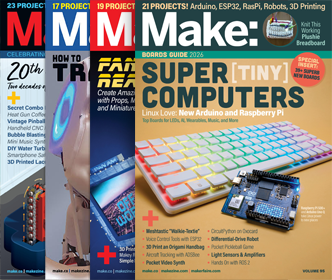
This week’s flashback is as fun as it is useful, brought to you by our own Make: Online contributing writer and the host of Make: television, John Edgar Park. Originally appearing on the pages of MAKE Volume 12, the Lego Recharger helps keep your gadgets all juiced up and stores your keys too. How incredibly convenient! Check it out.
Lego Recharger
By John Edgar Park
On a recent trip to Legoland, I saw a neat product in one of the stores: a Lego key rack with Lego brick keychains. What a great idea, I thought. With this I could come home, empty my pockets, and have a consistent place to hang my keys. But wait, what about all the other devices I just pulled out of my pockets, where do they go? And, for that matter, how will all their batteries stay charged?
Then it dawned on me. If I attached a powered Lego brick to each gadget to provide life-giving juice for their thirsty batteries, I’d solve 3 major problems in my life: lack of gadget organization, lack of battery power, and lack of Legos attached to all my possessions.
The first thing I did was to sift through my Lego Mindstorms and Technic bins. I grabbed some 9V motor wire bricks and a large baseplate to start playing with the design. I wanted to avoid modifying the bricks as much as possible. I also wanted color coding so I’d be less likely to accidentally hang my iPod on the cellphone’s brick, thus blowing up the iPod. This is a danger of universal connectors. Since the motor wire bricks come only in black, I needed to use additional bricks for color coding. I considered color-coded tiles on top of the device-end brick, but the smooth tiles always seem to hide a Lego’s, well, Lego-ness, so I opted for a 2×2 studded plate instead. Much more geek chic. I placed color-matched bricks below the respective charger-side brick on the base plate.
Next, I needed to splice the motor wire bricks onto my power adapters and gadget plugs. My first attempt involved cutting, stripping, and twisting corresponding wires together, soldering them, and then covering the splice with heat-shrink tubing. This worked great, but wasn’t very elegant. I wanted to leave these Lego dongles on my gadgets all the time, even when they were in my pockets, so getting the wire length down to a minimum was important. The splice wasn’t helping that.
Looking more closely at the Lego 9V motor wire brick, I noticed 4 pressure tabs on its ends. I grabbed a small screwdriver and pried the bottom off the brick. Inside, the insulated wire pair was pierced onto 2 sharp metal posts. The wire was held in place by the pressure between a small ridge of plastic and the recently pried-off bottom. Excellent. I’d now be able to cut all of my charger wires in half, and simply crimp a Lego motor wire brick onto each end.
For my key chain, I ripped off the original Lego design. I drilled a small hole into a 2×4 brick and then screwed a small screw eye into it. My apologies to Lego purists for all the drilling, but hey, Lego did it first!
The whole system was cheap and easy to build, works great, and keeps my devices organized and charged. I’ve gotten so used to it that I’ve installed an unwired counterpart key rack at my office.
MATERIALS
Lego 8×16 baseplate brick part #4204
Lego electric bricks 2×2×2/3 with 9V wire end (2) part #5306 aka motor wire
Lego 2×2 bricks (8) part #3003
Lego 2×4 bricks (2) part #3001
Lego 2×2 plates (2) part #3022
#214 screw eyes (2)
#6×1½” wood screws (4)
Various DC power chargers and devices
You can find most of these parts at online Lego stores on bricklink.com. Better yet, dig through your Lego bins and adapt the design to suit what you’ve got on hand.
TOOLS
Needlenose pliers
Small flathead screwdriver
Wire strippers
Diagonal cutters
Multimeter
Dremel tool with small drill and burr bits
for countersinking wood screws
Soldering iron (optional)
“Third hand” tool
1. Splice the gadget chargers with Lego brick connectors.
1a. Pry off the bottoms of both bricks of a Lego 9V motor wire for each gadget you plan to adapt. Remove the black Lego wire; you won’t be using
it.
1b. Plug in your charger, and test the plug with a multimeter to determine voltage and ground. For example, my Nokia phone charger has a negative exterior and a positive interior. Make a note of this, so you can double-check your work later before plugging the device in.
1c. For devices that carry data as well as power over their cables, such as iPods, you might need to consult an online wiring diagram to determine which pins carry voltage and ground.
1d. Unplug the charger, then snip the charger wire ¾” from the device-end plug. Carefully remove ½” of the outer tubing to expose the insulated inner wires of the charger and plug. Using a multimeter, determine the + and – wires on the charger and plug. Label these if they aren’t color-coded, so you can make the proper connections to the bricks.
1e. Lay the 2 power wires from the charger over the metal spikes of the Lego brick and push them into place with a small flathead screwdriver. Push hard enough to pierce the insulation. For extra insurance you can solder them in place.
1f. Repeat Step 1e for the device plug wires. Note which spike carries the positive charge, and remember to keep the circuit intact by connecting the positive wire to the proper spike on the plug-side brick.
For my 3rd-generation iPod dock connector, I couldn’t get voltage to the pins after splicing the wires. Once I finished cursing at Apple for using such ridiculously tiny connector pins, I fixed the problem with a $4 unsoldered dock connector from SparkFun Electronics (sparkfun.com, part #DEV-00633), by soldering the ground to pin 29 and the 12V DC+ to pin 19.
It’s worth noting that I killed a battery by grounding to pin 1 initially. At least I didn’t destroy my iPod.
1g. Push the bottoms back onto the bricks, listening for the satisfying “snick” of the tabs popping back into place. If it’s overly difficult to snap on, try moving a wire to one side of the plastic ridge inside the brick. A single pinched wire will hold the weight of most pocket-sized gadgets.
1h. Check your work by connecting the bricks with proper orientation, plugging in the charger, and testing voltage/polarity with a multimeter. This needs to read the same as it did in Step 1b, or else you may fry your costly gadget. Once you’re satisfied that it’s all wired correctly, plug your device into its Lego plug to test that it charges.
2. Create the Lego keychains.
2a. Drill a hole with the Dremel into one end of a 2×4 brick, passing through one cylinder wall on the underside.
2b. Screw in a screw eye, then attach your keys. Assuming you already had the ubiquitous 2×4 brick laying around, but had to buy the screw eye, this step just saved you about $3.98 off Lego’s $3.99 price for the same thing.
3. Build the Lego base station.
3a. Follow these illustrations to build the base station. Run the charger brick wires over the top of the 8×16 base brick and then behind it.
3b. Color-code the connections with a 2×2 plate on the device end and a 2×2 brick on the charger end. I used a white plate on my iPod plug, and a white brick under its corresponding charger brick.
Since the wire bricks are 2/3 normal brick height, the 2×2 brick provides a nice little ledge for additional insurance against your gadget falling tragically to the floor.
3c. Using the Dremel, carefully drill a hole for a wood screw into 4 of the 2×2 bricks. Use a burr bit to create an angled hole so that the screws can be countersunk. Now drop the wood screws into the holes.
3d. Mount the base station onto the 4 screw bricks. Measure, mark, and drill holes for mounting on your wall. Make sure you’re near enough an outlet to plug in the chargers. Depending on the wall you’ll be mounting this on, you may need to drill the wall for anchors as well.
3e. Pull the 4 screw bricks from the base station, then screw them into the wall. Remount the base station to the wall.
3f. Plug in your wall chargers, hang your keys and gadgets on their new home, and, most importantly, bask in the immense inner calm of knowing your stuff is now neatly organized and humming with power.
ADVERTISEMENT






















